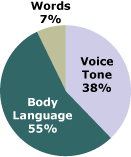What Is Communication?
Basically, communication is a sharing of information. It involves how we express our thoughts, ideas, and feelings, including what we say and what we don’t say. Our non-verbal communication, or body language—gestures and facial expressions—speaks volumes.
|
Verbal Communication is how we express ourselves orally using words. Spoken language includes enunciation, pauses, stutters, emphasis, and word choice. |
|
Non-verbal communication, or body language, is communication without words. It includes facial expressions, gestures, body movements, posture, eye contact, and tone of voice. |
If communication is more than 90% non-verbal, what implications do you think this has for you as a tutor?
Robert is a tutor working with Kenji on a writing assignment. He points out errors, and asks Kenji how they can be corrected. Kenji appears uncomfortable. He doesn’t look at Robert, or respond. Robert feels frustrated that Kenji is so passive, and he feels that because Kenji won’t look at him, he is probably bored with this lesson. |
This is a good example of a common cross-cultural communication problem. Robert is using a typical Western, learner-centred tutoring approach, expecting the learner to actively participate by discussing how he should correct his mistakes. In many cultures, the relationship between learner and tutor would be much different. The learner’s role would be more passive, and would expect that the teacher would simply demand that corrections be made. Also, in some cultures, it might be considered disrespectful for a learner to make direct eye contact with an instructor. In our culture, we want people to make eye contact, and it feels strange to us when they don’t.
BACK | NEXT
Copyright 2009 BC Ministry of Advanced Education and Labour Market Development
